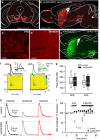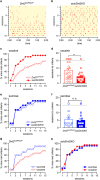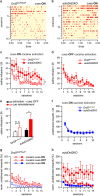Loss of feedback inhibition via D2 autoreceptors enhances acquisition of cocaine taking and reactivity to drug-paired cues
- PMID: 25547712
- PMCID: PMC4397408
- DOI: 10.1038/npp.2014.336
Loss of feedback inhibition via D2 autoreceptors enhances acquisition of cocaine taking and reactivity to drug-paired cues
Abstract
A prominent aspect of drug addiction is the ability of drug-associated cues to elicit craving and facilitate relapse. Understanding the factors that regulate cue reactivity will be vital for improving treatment of addictive disorders. Low availability of dopamine (DA) D2 receptors (D2Rs) in the striatum is associated with high cocaine intake and compulsive use. However, the role of D2Rs of nonstriatal origin in cocaine seeking and taking behavior and cue reactivity is less understood and possibly underestimated. D2Rs expressed by midbrain DA neurons function as autoreceptors, exerting inhibitory feedback on DA synthesis and release. Here, we show that selective loss of D2 autoreceptors impairs the feedback inhibition of DA release and amplifies the effect of cocaine on DA transmission in the nucleus accumbens (NAc) in vitro. Mice lacking D2 autoreceptors acquire a cued-operant self-administration task for cocaine faster than littermate control mice but acquire similarly for a natural reward. Furthermore, although mice lacking D2 autoreceptors were able to extinguish self-administration behavior in the absence of cocaine and paired cues, they exhibited perseverative responding when cocaine-paired cues were present. This enhanced cue reactivity was selective for cocaine and was not seen during extinction of sucrose self-administration. We conclude that low levels of D2 autoreceptors enhance the salience of cocaine-paired cues and can contribute to the vulnerability for cocaine use and relapse.
Figures





Similar articles
-
Enhanced sucrose and cocaine self-administration and cue-induced drug seeking after loss of VGLUT2 in midbrain dopamine neurons in mice.J Neurosci. 2011 Aug 31;31(35):12593-603. doi: 10.1523/JNEUROSCI.2397-11.2011. J Neurosci. 2011. PMID: 21880920 Free PMC article.
-
Enhanced vulnerability to cocaine self-administration is associated with elevated impulse activity of midbrain dopamine neurons.J Neurosci. 2000 Dec 1;20(23):8876-85. doi: 10.1523/JNEUROSCI.20-23-08876.2000. J Neurosci. 2000. PMID: 11102497 Free PMC article.
-
Cocaine supersensitivity and enhanced motivation for reward in mice lacking dopamine D2 autoreceptors.Nat Neurosci. 2011 Jul 10;14(8):1033-8. doi: 10.1038/nn.2862. Nat Neurosci. 2011. PMID: 21743470 Free PMC article.
-
Alterations in dopamine release but not dopamine autoreceptor function in dopamine D3 receptor mutant mice.J Neurosci. 1998 Mar 15;18(6):2231-8. doi: 10.1523/JNEUROSCI.18-06-02231.1998. J Neurosci. 1998. PMID: 9482807 Free PMC article. Review.
-
The role of D2-autoreceptors in regulating dopamine neuron activity and transmission.Neuroscience. 2014 Dec 12;282:13-22. doi: 10.1016/j.neuroscience.2014.01.025. Epub 2014 Jan 23. Neuroscience. 2014. PMID: 24463000 Free PMC article. Review.
Cited by
-
Inducible ablation of dopamine D2 receptors in adult mice impairs locomotion, motor skill learning and leads to severe parkinsonism.Mol Psychiatry. 2017 Apr;22(4):595-604. doi: 10.1038/mp.2016.105. Epub 2016 Jul 19. Mol Psychiatry. 2017. PMID: 27431292
-
Dopamine D2 autoreceptor interactome: Targeting the receptor complex as a strategy for treatment of substance use disorder.Pharmacol Ther. 2020 Sep;213:107583. doi: 10.1016/j.pharmthera.2020.107583. Epub 2020 May 27. Pharmacol Ther. 2020. PMID: 32473160 Free PMC article. Review.
-
High and low doses of cocaine intake are differentially regulated by dopamine D2 receptors in the ventral tegmental area and the nucleus accumbens.Neurosci Lett. 2018 Apr 3;671:133-139. doi: 10.1016/j.neulet.2018.02.026. Epub 2018 Feb 14. Neurosci Lett. 2018. PMID: 29454035 Free PMC article.
-
Distinct regulation of dopamine D2S and D2L autoreceptor signaling by calcium.Elife. 2015 Aug 26;4:e09358. doi: 10.7554/eLife.09358. Elife. 2015. PMID: 26308580 Free PMC article.
-
D1 receptor hypersensitivity in mice with low striatal D2 receptors facilitates select cocaine behaviors.Neuropsychopharmacology. 2019 Mar;44(4):805-816. doi: 10.1038/s41386-018-0286-3. Epub 2018 Dec 1. Neuropsychopharmacology. 2019. PMID: 30504927 Free PMC article.
References
-
- Alcantara AA, Chen V, Herring BE, Mendenhall JM, Berlanga ML. Localization of dopamine D2 receptors on cholinergic interneurons of the dorsal striatum and nucleus accumbens of the rat. Brain Res. 2003;986:22–29. - PubMed
-
- Bertorelli R, Consolo S. D1 and D2 dopaminergic regulation of acetylcholine release from striata of freely moving rats. J Neurochem. 1990;54:2145–2148. - PubMed
Publication types
MeSH terms
Substances
Grants and funding
LinkOut - more resources
Full Text Sources
Other Literature Sources
Medical
Molecular Biology Databases

